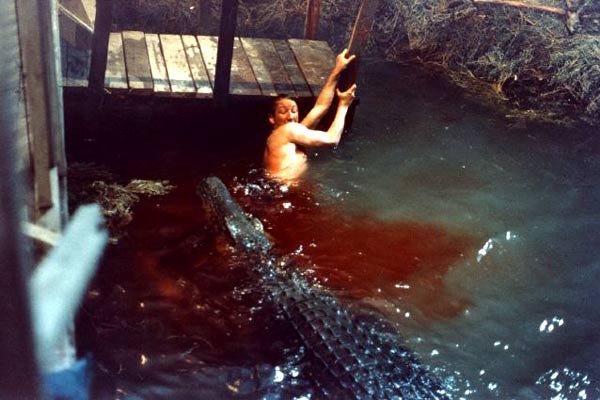Eaten Alive (1977)

"Eaten Alive" starts off right, when a young Robert Englund (5 years prior to becoming horror icon Freddy Krueger) slowly undresses before a young woman, before finally announcing, "I'm Buck, and I'm ready to f*ck."
And so goes Tobe Hooper's followup to "The Texas Chain Saw Massacre," one of the greatest horror films of all time, with this cheesy gem that shares much in common with its big brother.
Maybe too much.
Like TCM, "Eaten Alive" features an isolated backwater redneck who delights in filleting people. Clangy synth sound effects litter the film's soundtrack, mixed with closeups of young women's wide-eyed terror at the prospect of a gruesome death.
Heck, Marilyn Burns, the lone survivor from TCM, even makes an appearance and figures into the plot.
Speaking of plot...the film centers around Judd (a maniacal Neville Brand), the psychopathic owner of a ramshackle hotel in rural Louisiana. Judd is a killer who dispatches his victims via either a scythe, or by simply feeding them to the crocodile he keeps in a small lake next to his hotel.
When a young woman breaks free of a life of prostitution, she runs to Judd's hostel, where he promptly kills her. Soon others follow, including a married couple and their young daughter.
There is plenty of camp to be found, and the abject similarities to the classic TCM (and little other successes) makes one wonder if Steven Spielberg wasn't onto something when he allegedly took over production of "Poltergeist" from Hooper.
Hooper's signature amateurish production values, extreme closeups, and jarring soundtracks are almost copied from his last film. It's almost a warmup exercise for his campier sequel to TCM.
Brand achieves Schlock Vault legend status for his performance, which includes facial expressions so bizarre you don't know whether to scream or burst into laughter.
Englund also is fantastic as a young arrogant hick whose sadism kicks of the film, but he finds himself somewhat redeemed toward the end...kind of.
There's a stretch of the film where a young girl is chased under Judd's house and doesn't take advantage of numerous opportunities to escape.
There is a healthy amount of gratuitous nudity, including at least two sequences where the main purpose is to feature women slowly undressing.
The gator effects are significantly inferior to those seen three years later in "Alligator," and you see this reptile much less frequently than in that film. It would be easy to say that the makers of "Alligator" had the advantage of seeing this film first, but the effects are night and day.
In fairness, "Eaten Alive" features more special effects of other types than "Alligator," and would have to share its budget. On the other hand, the other effects were poor as well.
"Eaten Alive" also suffers from the indignity of having multiple alternate titles, including "Brutes and Savages," "Death Trap," "Horror Hotel," "Horror Hotel Massacre," "Legend of the Bayou," "Murder on the Bayou," "Slaughter Hotel," and "Starlight Slaughter."
"Eaten Alive" features a couple of memorable performances, two notable appearances by slasher-film legends, and not really much else worthwhile. If you catch this film on, say, IFC (as I did), it's worth watching, but it's not worth going out of your way to see unless you're a Tobe Hooper fan or a croc movie completist.


